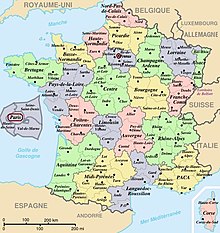At the end of the Last glacial period (10,000 BC), the climate softened and from approximately 7,000 BC, this part of Western Europe entered the Neolithic era and its inhabitants became sedentary. After a strong demographic and agricultural development between the 4th and 3rd millennia, metallurgy appeared at the end of the 3rd millennium, initially with the work of gold, copper and bronze, and later with iron.[31] France counts numerous megalithic sites from the Neolithic period, including the exceptionally dense Carnac stones site in Brittany (c. 3,300 BC).
In 600 BC, Ionian Greeks, originating from Phocaea, founded the colony of Massalia (present-day Marseille), on the shores of the Mediterranean Sea, making it the oldest city of France.[32][33] At the same time, some Gallic Celtic tribes penetrated some parts of the current territory of France, but this occupation spread in the rest of France only between the 5th and 3rd century BC.
Gallic tribes before the Roman conquest (58 BC to 51 BC). Note that Southern Gaul was already under Roman control (yellow) in 59 BC.
The concept of Gaul emerged at that time; it corresponds to the territories of Celtic settlement ranging between the Rhine, the Atlantic Ocean, the Pyrenees and the Mediterranean Sea. The borders of modern France are approximately the same as those of ancient Gaul, which was inhabited by Celtic Gauls. Gaul was then a prosperous country, of which the southernmost part was heavily subject to Greek and Roman influences. However, around 390 BC, the Gallic chieftain Brennus and his troops made their way to Italy through the Alps, defeated the Romans in the Battle of the Allia, and besieged and ransomed Rome.
The Gallic invasion left Rome weakened and encouraged several subdued Italian tribes to rebel. One by one, over the course of the next 50 years, these tribes were defeated and brought back under Roman dominion. The Gauls continued to harass the region until 345 BC, when they entered into a formal peace treaty with Rome. But the Romans and the Gauls would maintain an adversarial relationship for the next several centuries and the Gauls would remain a threat in Italia.
Around 125 BC, the south of Gaul was conquered by the Romans, who called this region Provincia Romana ("Roman Province"), which over time evolved into the name Provence in French. Brennus' siege of Rome was still remembered by Romans, when Julius Caesar conquered the remainder of Gaul and overcame a revolt carried out by the Gallic chieftain Vercingetorix in 52 BC.
The Maison Carrée was a temple of the Gallo-Roman city of Nemausus (present-day Nîmes) and is one of the best preserved vestiges of the Roman Empire.
Gaul was divided by Augustus into Roman provinces, the principal ones being Gallia Narbonensis in the south, Gallia Aquitania in the south-west, Gallia Lugdunensis in the center and Gallia Belgica in the north. Many cities were founded during the Gallo-Roman period, including Lugdunum (present-day Lyon), which is considered to be the capital of the Gauls. These cities were built in the traditional Roman style, with a forum, a theatre, a circus, an amphitheatre and thermal baths. The Gauls mixed with Roman settlers and eventually adopted Roman speech (Latin, from which the French language evolved) and Roman culture. The Roman polytheism merged with the Gallic paganism into the same syncretism.
Around the 3rd century AD, Roman Gaul underwent a serious crisis with its "limes" (fortified borders protecting the Empire) crossed on several occasions by Barbarians.[38] The weakness of the central imperial power, at this time, led Gallo-Roman leaders to proclaim the independence of the short-lived Gallic Empire,which ended with the Battle of Châlons in 274, which saw Gaul reincorporated in the Roman Empire.
Nevertheless, the situation improved in the first half of the 4th century AD, which was a period of revival and prosperity for Roman Gaul. In 312, the emperor Constantin I converted to Christianity. Christians, persecuted until then, multiplied across the entire Roman Empire. But, from the second half of the 4th century AD, the Barbarian Invasions started again,and Germanic tribes, such as the Vandals, Suebi and Alans crossed the Rhine and settled in Gaul, Spain and other parts of the collapsing Roman Empire.
At the end of the Antiquity period, ancient Gaul was divided into several Germanic kingdoms (Early Francia (North), Alamannia (North-East), Burgundia (East), Septimania (South), Visigothic Aquitania (South East)) and a remaining Gallo-Roman territory, known as the Kingdom of Syagrius (West). Simultaneously, Celtic Britons, fleeing the Anglo-Saxon invasion of Britannia, settled the western part of Armorica (far West of Gaul). As a result, the Armorican peninsula was renamed Brittany, Celtic culture was revived and independent petty kingdoms arose in this region.
 France
France France
France France
France France
France France
France
No comments:
Post a Comment